
Faster than faster. That’s what Vivo claimed the V3 and V3 Max were, and we found that the two devices lived up to that cheesy title. With the V5, the successor to the V3, Vivo is putting the focus on selfies. The V5’s front camera has a 20-megapixel resolution and a larger sensor size than what you find on regular selfie cameras, and the company is calling the selfie snapper a “Moonlight camera.” The V5 also gets an LED flash next to its front-facing camera, which Vivo claims can produce “lighting effects of a professional photography studio, giving you the soft radiant complexion of a supermodel for a beautiful picture-perfect image every time.”
Vivo V5
What Is Good?
- Display isn't so bad
- Good sound through loudspeaker
- Great battery life
- Optimised, feature-packed software
- Fast fingerprint sensor (when it works)
What Is Bad?
- Moonlight selfie camera isn't great
- Not great at high-end gaming
- Rear camera is mediocre
- Average audio quality through earphones
- Display should have been sharper
I’m not making this up: those words have been lifted directly from Vivo’s website. The company thinks the front camera setup on the V5 can capture “perfect selfies”, and looking at the spec sheet, consumers inclined to take selfies will be enthused by the device. Vivo’s devices have received considerable interest according to data available to MySmartPrice, and with the brand heavily promoting the V5, the device’s hoardings are plastered across major urban centers and outside mobile stores.
However, while the likes of Xiaomi, LeEco, and Lenovo are attracting consumers with top-tier specs at rock-bottom prices, Vivo is asking you to part with nearly ₹18,000 and offering hardware like a 5.5-inch 720p display (which comes with a tempered glass out of the box and no mention of whether it has something like Gorilla Glass) and a MediaTek processor. These specs can only be considered budget components when you take into consideration what you find on devices like the Xiaomi Redmi Note 3 and the Lenovo Z2 Plus.
In fact, the V5 has nothing fancy on offer except its 20-megapixel front camera, suggesting Vivo is rather confident of its performance. But does the Vivo V5 stand up to its claim of giving you the perfect selfies, or is it all smoke and mirrors based on the specifications of the front snapper? Can the V5 offer you an experience worth the asking price? Let’s find out in the review.
Fairly basic, iPhone-like design
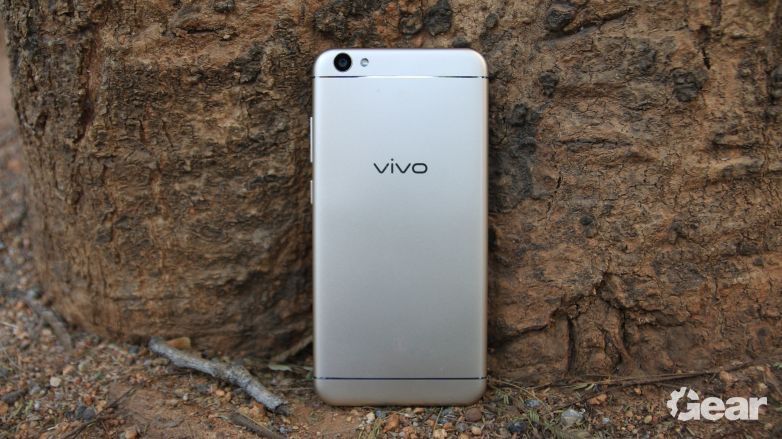
Were it not for the home button on the front, the Vivo V5 could have passed as a nice iPhone clone. Not just the iPhone – the V5 looks like quite a few other smartphones from Chinese manufacturers, and it’s clear every company is using a generic design and slapping its logo and a few small touches for differentiation. The back of the phone is made out of plastic, but hand it to someone on the street and they might just mistake it to be metal. Unfortunately, there’s no metal on this device, which is one of the biggest disappointments considering even Samsung is making metallic smartphones in this price range.
The Vivo V5 is fairly easy to use with one hand and is weighted just right, resulting in a comfortable in-hand feel. Overall, the phone is constructed well, with no loose corners. My only gripe is the home button, which can get in the way when you’re swiping up from the bottom of the screen, something you have to do to access the multitasking screen and shortcuts to functions like Wi-Fi and brightness. This is more a fault of the way the software works than the hardware itself, but Vivo should have taken this into consideration before opting for a front-facing fingerprint sensor.
Nice LCD display, but the resolution is a downer
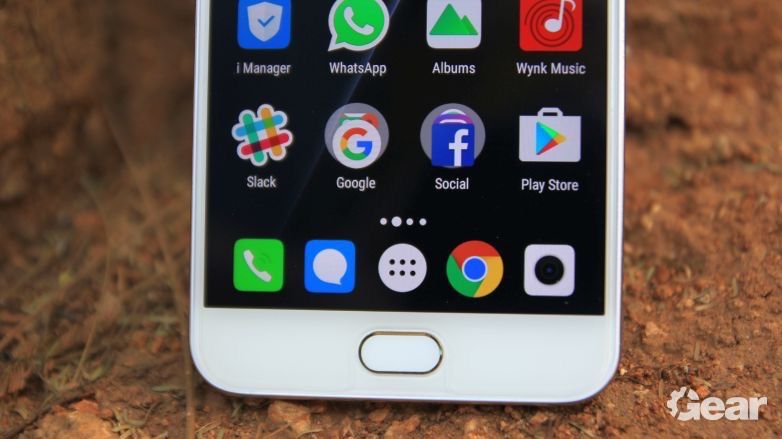
The Vivo V5 features a 5.5-inch LCD display with a resolution of 1280×720 pixels. Yes, in this day and age that resolution looks too low for a 5.5-inch screen, but in real-life usage, the V5’s display isn’t all that bad. Colors have high saturation for an LCD panel and the display can get sufficiently bright. You can spot pixelation if you look at the screen too closely, but in general usage you shouldn’t find it to be a problem. At the end of the day, the 720p display only disappoints because of the price tag of the phone, and a Full HD panel would have made a notable difference in the overall viewing experience.
‘Moonlight’ selfies? Not really

Since the Vivo V5 is all about the selfies, let’s talk about the phone’s cameras first. The front camera uses a Sony IMX376 sensor with f2.0 aperture and a 5P lens – you don’t usually see these aspects being mentioned when it comes to a phone’s front-facing camera, and the reason why is very apparent when you use the V5 to take selfies. Outdoors in natural light, the V5 can certainly produce selfies with a lot of detail that you won’t find on lower-resolution selfie cameras, but indoors and in poor lighting, it is only slightly better than regular phones.
Photos come out soft when the lighting isn’t right, and the LED flash on the front (which stays lit consistently instead of working as a true flash) only helps illuminate your face when it’s extremely dark. I took a couple of shots outside with and without the flash in a dark area, and you can clearly see the limited nature of the flash in the comparison shot below. All the talk about giving you that “studio lighting” for a supermodel look? That would maybe stand true if you and your friends go extremely close to the camera, but that’s not how people take selfies in real life.

The rear camera is also nothing to write home about. In fact, it’s almost as if Vivo put no effort behind it, as the 13-megapixel rear camera takes strictly average photos. There isn’t a lot of detail unless you’re shooting outside on a bright sunny day, and the camera is sometimes frustratingly slow to focus indoors. For a phone that costs almost Rs. 18,000, the performance of the primary camera is unforgivable. I know the focus is on the front camera with this device, but that doesn’t excuse the clear lack of effort when it comes to what is still the primary camera.
Vivo builds in a number of features in the camera app – there’s gender detection, a palm gesture for initiating photo capture (which didn’t work very well in my experience), beauty filters, and the ability to take photos using your voice. A number of shooting modes are present for the primary camera, including night, HDR, action and panorama modes. The night mode comes in handy in dark situations as it can capture more light than the normal shooting mode, although you have to keep the phone very still for a few seconds for night mode to work properly.
Not exactly a great performer
The Vivo V5 comes with an octa-core MediaTek processor under the hood, paired with 4GB of RAM. The MediaTek processor is a clear downgrade over the Snapdragon chips that powered the V3 and V3 Max, but performance on the V5 is thankfully not a problem. The UI remains smooth for the most part and apps launch quickly, although there were a few instances when Chrome would take up to five seconds to fire up. This might have something to do with the phone killing the app in the background, although that shouldn’t really be an issue on a device with 4GB of RAM.
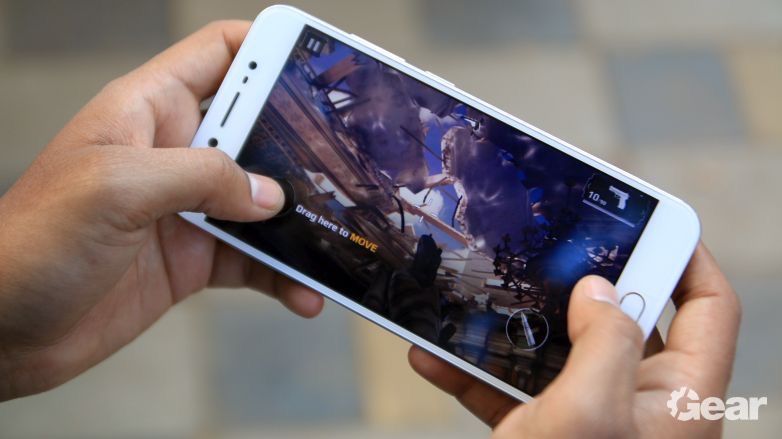
Also, gaming is where the V5 isn’t as impressive as we have come to expect from devices in this price range. Regular games like Temple Run or Candy Crush run fine, of course, but you will have to make do with slightly lowered graphics in titles like Modern Combat 5. Asphalt 8, one of the most popular games on mobile devices, offers smooth frame rates for the most part, but performance can dip from time to time. Vivo really should have stuck with the more powerful Snapdragon chips instead of downgrading to a MediaTek SoC, as the performance dip is noticeable compared to both the lower priced V3 and the costlier V3 Max.
The fingerprint sensor on the Vivo V5 isn’t as good as the one we saw on the V3 or V3 Max either. It’s as accurate and as fast when it works (it ranks at the top in those areas), but there are times it misses out on detecting your fingerprint and fails to respond. This is likely to do with the shape of the button – it’s not a square like the rear-facing fingerprint sensors you find on most devices, which increases your chances of not covering the entire surface every time you keep your finger on the sensor.
Battery life that you can count on
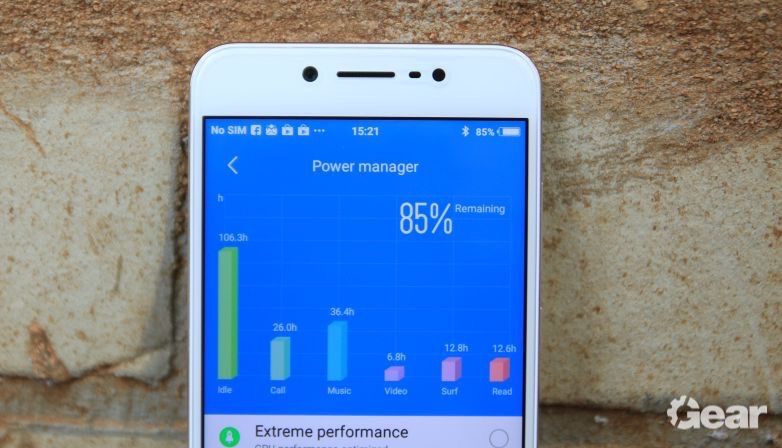
When you pair a low-resolution screen and a battery capacity that is often seen on full-fledged flagships with power-hungry hardware, you’re bound to get outstanding battery life, and that is certainly the case with the Vivo V5 as well. Okay, so the battery life might not be outstanding – phones need to last at least a day and a half to claim that title, but the V5 can easily get through the entire day. I rarely found myself charging the phone to 100 percent, as even with a 30 percent charge left the V5 can go on for a few hours. It’s a good thing, too, as Vivo doesn’t offer any form of fast charging, so you have to keep the phone hooked to a charger for up to two hours for the battery to reach 100 percent.

Audio quality is a mixed bag
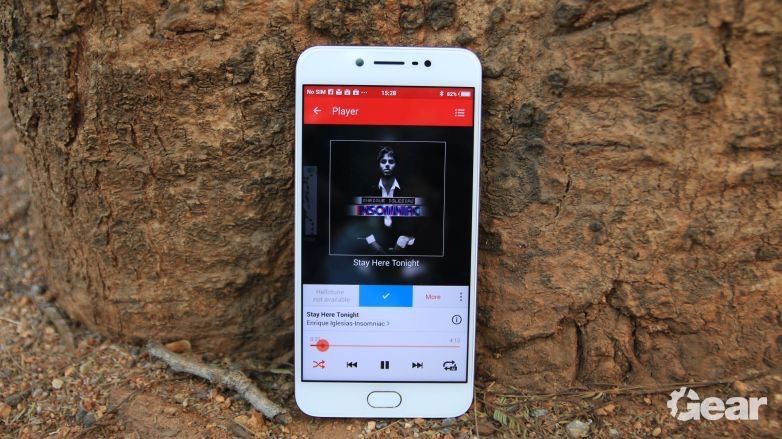
The Vivo V5 features a single bottom-firing loudspeaker, one that can get loud and has sufficient thump. As with most smartphone loudspeakers, the V5’s is geared toward the higher frequencies (treble), but you can hear the bass in music tracks rather clearly as well. The speaker gets quite loud, and the produced sound doesn’t have any noticeable distortion unless you’re listening to something with a low bit rate.
The bundled earphones are quite mediocre in quality. The sound they produce is shrill to the point of being a nuisance, and there’s not a lot of bass to be heard even in tracks with a high focus on beats. The inbuilt Hi-Fi mode, when enabled from the settings menu, increases the volume and adds a surround-like effect, but the sound quality doesn’t get a noticeable boost in quality. Using higher quality headphones did improve audio quality, but there’s still a lack of definition in the low and mid-range.
The V5 does a decent job at calls, but that’s about it. The phone never had issues with latching on to either the Airtel or Jio 4G network, although switching between the two SIMs for mobile data and changing network mode can be a time-consuming affair as the phone hunts a fair bit before those changes come into effect.
Optimised software packed with features
As was the case with the V3 and V3 Max, the iPhone inspiration is most apparent in the software. The V5 runs Android 6.0.1 Marshmallow with Vivo’s Funtouch OS on top, and everything is designed to look similar to iOS. However, it’s not a bad thing unless you can’t stand Apple’s operating system. Stability was an issue at first as the phone would restart on its own often (especially when streaming music over Bluetooth), but this was fixed after a couple of software updates.
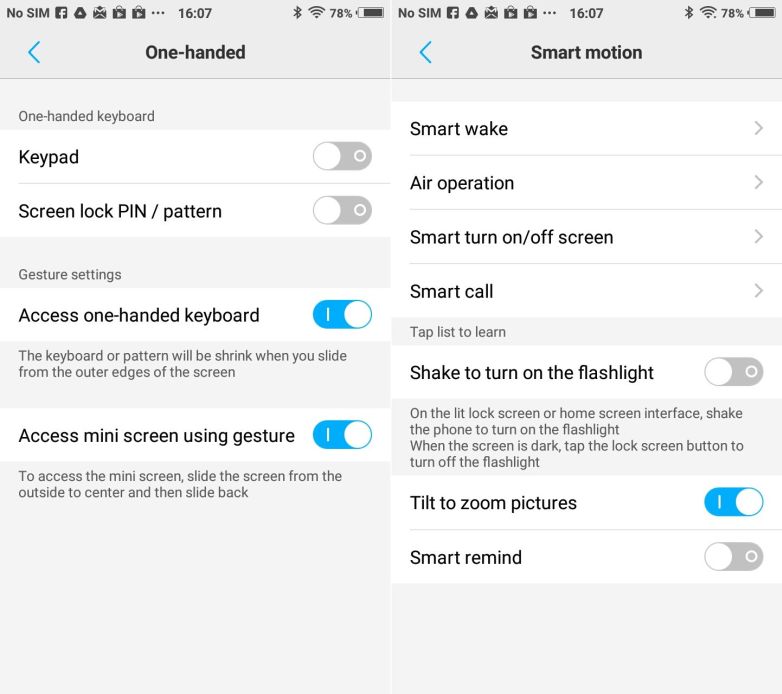
Funtouch OS is packed to the brim with features, including numerous gestures for waking up the phone and other functions. You can draw different symbols on the screen when the display is off to do things like changing music or launching the browser; the phone also supports double-tap-to-wake to turn on the display, or to turn it off when it is lit up. You can even enable the option to light up the display when you take the phone out of your pocket, which is very handy in day-to-day usage.
Other features include a one-handed mode, a screenshot function that can record audio, and the ability to use two apps side by side. Unfortunately, the multi-window functionality is limited to the video and messaging apps. The phone also has a blue light filter for the display, dubbed Eye Protection, that turns the screen yellow. This is to reduce strain on your eyes and to make it easier for you to fall asleep; you can customise the level of the blue light filter and set it to enable or disable at a specified time.

Conclusion
Is the Vivo V5 worth buying? No. The phone can certainly take good selfies, but the front camera isn’t all that better than the competition for it to be the primary reason to buy the V5. The selfie flash isn’t helpful unless it’s really dark around you, and selfies taken without flash in low-light conditions aren’t much better than those taken on other phones.
When the most touted feature of a smartphone fails to deliver an excellent experience, one must turn towards other aspects of the device to look for reasons to give it a recommendation. Sadly, the V5 doesn’t excel in any area. It does a decent job in most, but when you are asking the consumer to part with nearly ₹17,000, decent doesn’t cut it, especially when you have devices like the Lenovo Z2 Plus (review) and the LeEco Le Max 2 in the same price range.

As always, the case for a Vivo smartphone can be made by the fact that it is available for purchase both offline and online. But there’s competition in the offline market as well. Samsung’s Galaxy J7 Prime is a prime example (no pun intended) – it’s got a higher-resolution display, similar software performance, a more premium design, and better battery life. The J7 Prime’s online-only cousin, the Galaxy On Nxt (review), is an even better deal, coming in at under ₹17,000 and offering higher internal storage.
I would go so far as saying that the V3 and V3 Max are also better alternatives – these phones only suffer from a poorer selfie camera and an older version of Android while offering superior performance thanks to the Snapdragon chips. The V5 isn’t a bad smartphone by any means, but even if selfies are of the utmost importance to you, I would recommend looking at other smartphone options instead of settling for the Vivo V5.




















